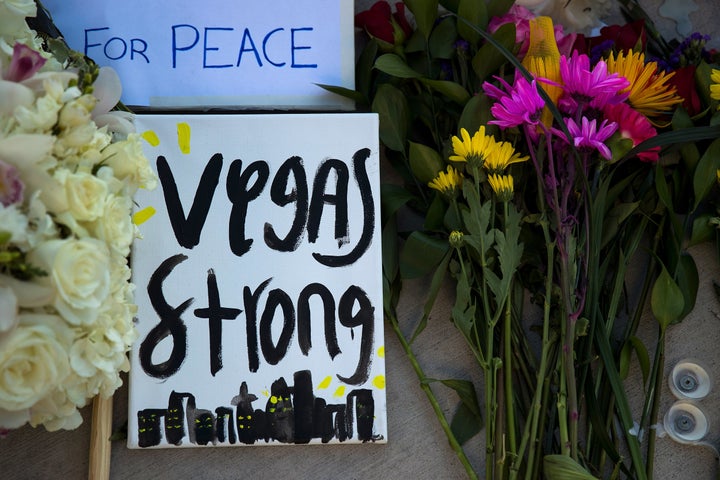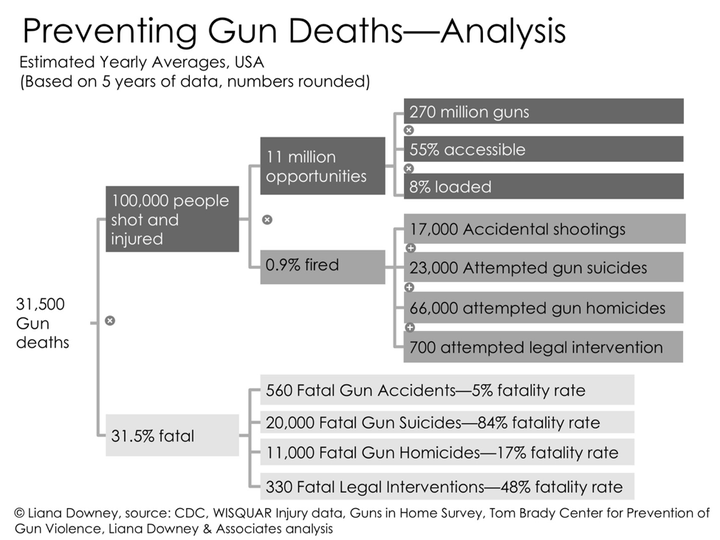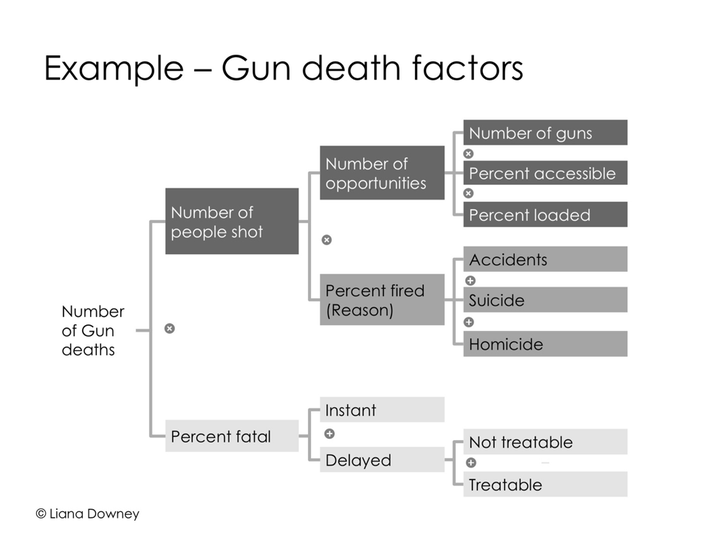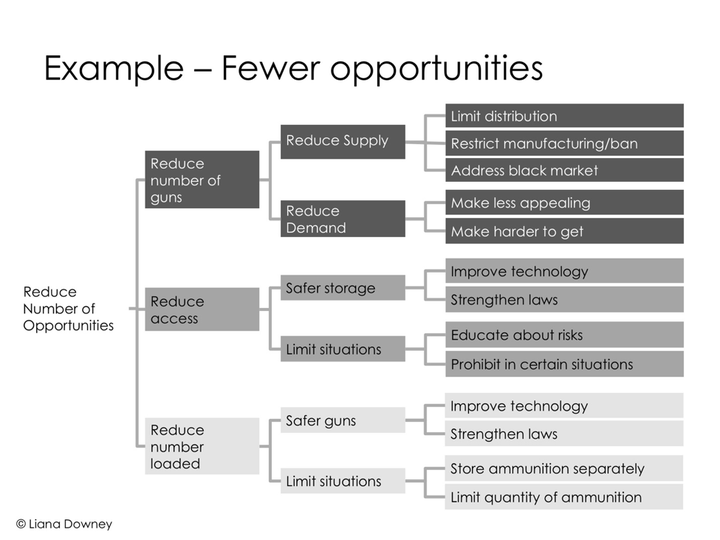
Another day, another horrific incidence of gun violence. I feel angry, and frightened. How about you? More than 63 percent of Americans say they fear being the victim of a gun attack and more than half say they are supportive of stricter laws covering the sale of firearms. Yet regardless of which party is in power, changes have been few.
What’s the problem? Is it the political sway of the NRA? Is it simply a Congress who can’t or won’t pass legislation? Maybe. But this much is clear. Anger is not enough. Fear is not enough. We have to accept that those of us who want reform — are a big part of the problem.
We lack the one thing every successful change-campaign needs. We lack clarity.
CBS News reported that the response of democratic legislators to the Orlando Massacre was to “shout down Speaker Paul Ryan and demand a gun control bill.” Was that helpful? It sounds like action, but what were they actually asking for? Moms Demand Action for Gun Sense in America told supporters on social media to “use this form to call your US senator and demand action on gun violence now, and pass it on.” What action?
Terms like ‘gun control’ and ‘gun reform’ are notoriously vague. Do they mean tightening background checks or that the government is “coming to take your guns”?
This ambiguity is deliberate. Knowing full well that the the pro-gun lobby is quick to raise the cry “they’re coming to take our guns”, most politicians and protesters — even those in support of reform — hide behind indirect terms, in the hope that they won’t ruffle feathers. Yet the opposite happens. Those who lobby on behalf of the gun industry, whose job it is to keep demand and supply of guns growing, seize on the lack of clarity and paint a doomsday scenario for gun owners.
But organizations that create pivotal, lasting change are adept at setting and working towards clear goals.
“Terms like ‘gun control’ and ‘gun reform’ are notoriously vague. Do they mean tightening background checks or that the government is 'coming to take your guns'?”
D. A. Hendersen, the American epidemiologist who spearheaded global efforts to successfully eradicate smallpox, has pointed to the unifying goal — “zero deaths from smallpox” as fundamental in achieving the change, which has saved sixty million lives, and counting. Leaders of the recent successful national effort to house 100,000 chronically homeless individuals used the rallying cry of “100,000 Homes,” to unify more than 180 communities around the country, and spur them to action. Numerous commentators have noted the power and intelligence behind the Marriage Equality Movement, as a simple, unifying objective in the march towards equal rights for the LGBT community.
Goals can motivate and unify. But to do so, they should define an end-state, they must be crystal clear, and by my observation across 20 years of advising governments and nonprofits, it helps if they are spine-tinglingly inspirational.
By those measures, ‘gun reform’ is a clear failure.
It doesn’t define an end-state, it’s not clear, and it’s certainly not spine-tingling.
We need to stop relying on the ambiguous concept of gun reform and move to something that all of us, can agree on.
It’s time to save lives. Let this be the rallying cry for a divided country.
Analyzing the best available data over the last five years suggests that, on average, the US has lost 31,500 lives to guns every year.
Let’s halve the number of gun deaths. Let’s save 15,000 lives a year.
Even making a conservative assumption about future deaths, we could aim to save 15,000 lives per year. Just pause for a moment on that. 15,000 people who could go on to be inventors, architects, peace-makers, entrepreneurs or life-saving scientists. Does that sound inconceivable? It shouldn’t — similar campaigns have been successfully waged and won. There are 12,000 fewer deaths per annum from drunk-driving than there were before Mothers Against Drunk Driving launched their campaigns, and there are 40,000 fewer deaths each year from workplace accidents than there were in the ’20’s, as a result of similar systematic campaigns.
A clear goal does more than just unify. It allows you to get really scientific.
What are the forces at work? How can they be addressed? In the case of a gun death — there must be a gun available, loaded and accessed. It must be fired, and the shot must be fatal. This might seem obvious, but making these forces explicit has huge power. It allows you to systematically identify, review and prioritize the available options, based on the likely impact and feasibility of implementation.
So let’s take a quick look at the data. It is imperfect — but it’s enough to get started. We know something about the number of people who are hospitalized from gunshot wounds, the stated cause, and the fatality rates. We know the number of total reported gunshot wounds is likely highly conservative, some estimates put it more in the 400,000 range, but a conservative figure is that there are at least 100,000 examples of reported gun-shot wounds on average each year. We know there are between 270-310 million guns — more than one for every one of the 214 million adults in the country, but we also know that these are not evenly distributed.
There are about 6 million people who own more than 10 guns each.
Based on what gun-owners report about how and where they store their guns — more than half keep them accessible and about eight percent of those guns are stored loaded — it means there are, in any given year, roughly 11 million opportunities where someone can pick up a loaded gun and fire it with relative ease. That’s a lot of opportunities for harm.

With this basic information in mind, let’s come back to the idea of a unifying goal — saving lives. What would happen if we truly identified common ground, and set about systematically identifying the options to achieve it? Even the NRA has said they’re in favor of reducing gun fatalities. So let’s start there.
Imagine for a moment that we do not yet agree how we’ll get there, but we do agree on the aspiration — to halve the rates of gun death in this country. It’s clear. It’s measurable. We’ll know when we get there.
It changes the game substantially, because starting with the end state in mind, allows you to break down complex problems into a very clear set of solutions.
Of course, people may differ on their hypotheses — the NRA for example, has long held that the issue is inadequate arming (apparently 310 million guns just aren’t enough), but let’s leave that aside for a moment, and simply capture the range of possibilities. For a person to be fatally shot, a loaded gun must be accessed, fired, and cause fatal injuries. That we can all agree on.

Then, you can start to lay out and prioritize the full set of choices to achieve your goal. That includes both looking at ways to reduce fatalities from injuries, as well as reducing the number of motives people have for firing, and the number of opportunities people have to access weapons. So take for example, the issue of how to reduce the number of opportunities people have to access weapons (down from the estimated 11 million today). You can think about ways to reduce supply and demand of guns; to reduce access to guns through safer storage, and to reduce the number of guns that are stored loaded.
The chart below shows just one of the main branches broken out — that for reducing the number of opportunities. To be systematic, you must also investigate ways to reduce fatalities and the percent fired.

Then — if the goal is to save lives, you move beyond hypotheses into testing. What happens if you increase response time? Does it reduce accidents when it’s very obvious that a gun is loaded (say with a red light)? What happens when you put in place better suicide prevention programs? And yes — what happens when you reduce access to guns (either through limiting the types of guns, the people who can access them, or the sales channels through which they can be accessed).
Evidence strongly supports the idea that reducing access to guns is one of the most effective approaches (particularly on reducing suicides and domestic violence)— however, the ultimate prioritization of strategies should come down to two things. What’s likely to have the biggest impact and what’s feasible—that is, what laws can realistically be passed?
You go where you can. You implement, then track, then implement again. And this is not impossible. Other countries, have made reforms and their citizens do not live in fear of being shot every time they go to the movies, to the mall, or to a concert. I know this first hand — I lived in Australia at the time they reformed their gun laws (and keep on acting—Australia just got rid of another 26,000 guns).
But in the U.S. — because we have no commitment to a goal, there is no tracking. In fact, it’s worse than that. For 20 years, the Center for Disease control has been explicitly banned through a congressional ruling from funding any efforts measuring and tracking the effectiveness efforts to reduce gun violence. But if we all agree on the goal — to save lives, then a commitment to measurement becomes even easier.
“Guns are big business in the U.S. Anything that reduces the supply or demand of guns comes into conflict with the interest of gun manufacturers.”
There is another challenge. Guns are big business in the U.S. Anything that reduces the supply or demand of guns comes into conflict with the interest of gun manufacturers. It’s a huge part of why, even though many states and countries have found numerous effective strategies for reducing gun violence, there has been so little systematic progress across the US.
Gun manufacturers are on the front foot here. There are hundreds of examples of proposed laws (drafted by lobbyists) which restrict efforts to reduce gun supply or demand. There are endless examples — gag-orders on pediatricians hoping to talk to their patients about the dangers of guns in the home; the recent roll back of state-sharing of offender registration; the gag order on the Center for Disease Control and so on. It is a long and disheartening list.
We have two courses of action — diminish the influence of the manufacturers or invite them to the table. The choice is theirs. Will the industry commit to the goal and allow adequate tracking? If they won’t agree on a goal to save lives, then their motives are clear — they value money not Americans.
It’s not enough to complain. It’s time to save lives.
Liana Downey is the author of Mission Control: How Nonprofits and Governments Can Focus, Achieve More and Change the World (Taylor Routledge, 2016), which includes a chapter outlining the strategies and research around gun reform. Downey is a strategic advisor, who has advised international governments on crime reduction and justice reform. Downey taught at NYU’s Robert F Wagner’s school of Public Policy, holds an MBA from Stanford and is a former leader of McKinsey & Company’s government practice in Australia.
